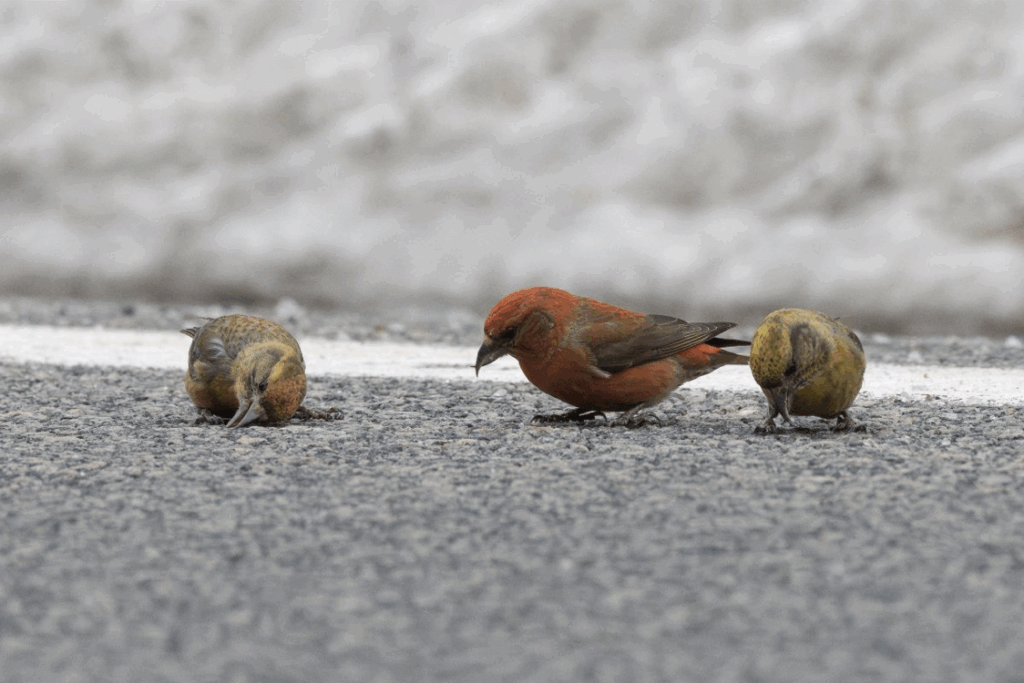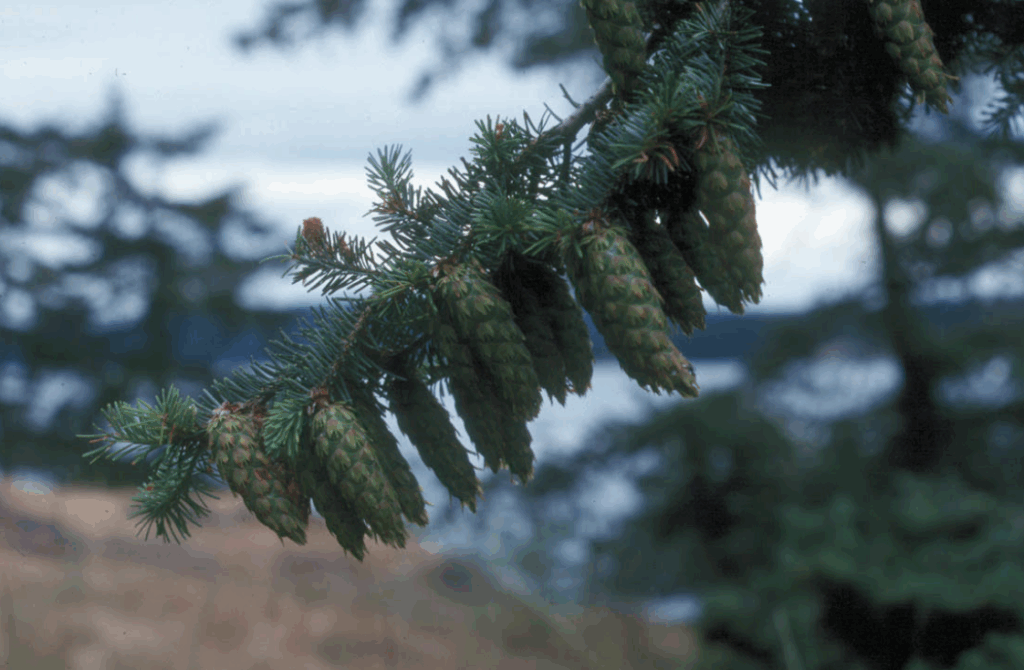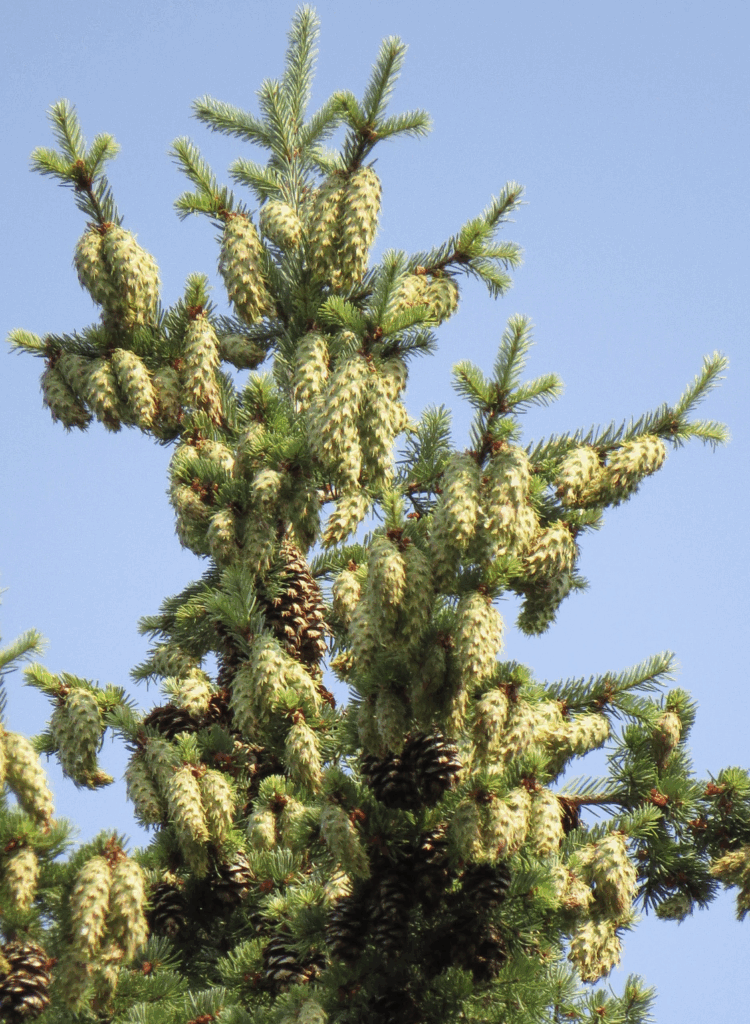The Crossbill Story, Part 5:
by Tom Hahn:
We left off last time with the swarm of Type 2s (and a few Type 4s) breeding in the winter/spring of 1989 using the big ponderosa cone crop at the Devils Table field site east of Mount Rainier, Washington.
Here I need to turn back the clock from that a bit to very early summer 1988. I had to cast around a bit to locate a place where crossbills were settling to breed in the east Cascades. I really didn’t zero in firmly on that Devils Table site until mid-July. Prior to that, I had found lots of developing ponderosa cones at various places east of the Cascade crest, but it wasn’t clear if crossbills would settle in any of those places to breed, and I had been getting pretty nervous that I might not find a good place to study breeding birds despite the big ponderosa cone crop.
The San Juan Islands were a totally different story.
My advisor John Wingfield and Gordon Orians had both suggested I explore the San Juans early on when I expressed interest in studying crossbills, and I had spent several weeks at the Friday Harbor Labs taking a class in summer 1987. So I made a trip out near the end of June, 1988. In addition to the Friday Harbor Laboratories on San Juan Island, the University of Washington has a 400 acre plot on the small and sparsely-populated Shaw Island. I visited both Friday Harbor Labs and Shaw on this trip, and ended up focusing my field work on Shaw.

The habitat on the San Juans can be surprising to a first-time visitor because of the very strong rain shadow cast by the OIympic Mountains to the southwest. The winter storms out of the north Pacific swirl counter-clockwise so that the strongest rain shadow is on the northeast side of the range. For instance, the little town of Sequim (pronounced “Skwim”) on the northeast Olympic Peninsula averages only around 16” of rain annually, and San Juan Island, almost due north of Sequim across the Strait of Juan de Fuca, only gets about 25”. By contrast, roughly 80 miles SW of Shaw Island, where the west-facing valleys of the Bogachiel, Hoh, Queets, Quinault, and Humptulips Rivers get first shot at wringing the moisture out of those storms, annual rainfall can be almost 10 times that. So the San Juans are dry, and the forests at the Friday Harbor Labs and on the Shaw Island property are a mixture of Douglas-fir, grand fir and western redcedar; there are almost no Sitka spruce or western hemlock trees like there are on the western OP. I mention all this because the crossbills I found on the San Juans were not what I expected, given how far west the San Juans are.
On my exploratory trip in late June, 1988, things looked promising at the Anacortes ferry terminal; there were lots of developing Doug-fir cones, and enough Type 4s right there to be conspicuous despite all the vehicle noise. Out on the islands, the developing Doug-fir cone crop was gigantic, and the place was inundated with Type 4s by the end of June. I honestly had been expecting Type 3s, but as it turns out, despite these islands being so far west, the San Juans really were a Type 4 hotspot.
The birds were just starting to use the immature Doug-fir cones, pulling them off the trees, working them over thoroughly, and dropping them to litter the ground with their scales splayed out. By the end of July, I estimated that a couple of the big Doug-firs near the caretaker Jack Temple’s house had had roughly 80% of their new cones removed by crossbills. This phenomenon is really common with the smaller- and softer-coned western tree species – Engelmann and Sitka spruce, western hemlock, and Douglas-fir – but contrasts dramatically with how crossbills handle immature ponderosa cones, which they pry open in situ. Anyhow…by about the middle of July 1988, I was into two separate crossbill “swarms” – the Type 2s (with a few Type 4s) on the big ponderosa cone crop near Devils Table, and these Type 4s on the big Douglas-fir crop on the San Juans – and I ended up splitting my field time bouncing back and forth between the two locations in 1988-89.
The Type 4s nested abundantly in July and August on the Shaw Island property, and begging fledglings were common in early September. Crossbill family groups with young fledglings provide good bird watching entertainment, as the fledglings are absolutely relentless in their begging, getting right in their parents’ faces and even trying to perch on them – clearly not helpful. Crossbill fledgling begging calls are repetitive, often doubled sounds that can be rendered well as “chi-too,” with the “chi” part higher in pitch than the “too.” A typical series might go “chi-too, chi-too, chi-too-too-too-too” (repeat endlessly). They are similar in pattern but not tone quality to the “tee-yoop” fledgling calls of American goldfinches.

The Doug-fir cones at Shaw Island opened and started shedding seeds during the dry, warm days of late August and early September, 1988. Singing activity seemed to persist longer into September than over at Devils Table, but by October and particularly November, the birds were in flocks and didn’t seem to be nesting any more. Some modest singing activity still occurred during autumn, particularly during nice weather, but the few adults I was able to catch were in or finishing molt and were not in physiological condition for breeding. In December I still detected occasional begging fledglings that would have come from the last few nests initiated back in October, but by the time of my visit in February, 1989, I was detecting no begging fledglings or streaky-brown birds at all – further evidence that nesting had stopped by mid-autumn.
My visit to Shaw from 16-19 February 1989 was fascinating. I arrived at the Anacortes ferry terminal around 10:15 am on 16 Feb, and my notes say: “Raining, slushing, all the way up from Seattle” and at 10:28, while waiting for the ferry: “turning to 100% snow – blowing. Snowing hard.” It snowed throughout the ferry trip out to Shaw, and was still snowing when I got there around 11:30. Was this really going to be a productive field trip??
The crossbills appeared unphased by the weather. There were lots of Type 4s around, and despite it continuing to snow, they were singing a lot. Juncos and siskins were also abundant and singing, but they were in big wintering flocks, and their song was the warbly chatter typical of non-breeding birds of those species when in big groups. In contrast, the crossbill song was loud and polished, and often was associated with “moth flights” (slow “swimming” wingbeat flights accompanied by loud song) common in breeding males. I observed no fledglings or entirely streaky-brown birds.
Enough wet, heavy snow accumulated on the trees that big branches were regularly cracking off the Doug-firs, but even so, females were nesting. One nest was particularly memorable. I had been observing a little group of males foraging and hanging out together when 2 females appeared, each joining a different one of the males. One female was fed by the male she joined, and the other and her male darted off together. I followed at a run and saw them disappear into a lodgepole pine, and I fixed on a likely spot when the male reappeared and then departed to a nearby Douglas-fir. I found a vantage point from which I could see into the suspected area with my spotting scope and pretty quickly located the female incubating. She was only visible when she peeked up over the twiggy rim of the nest, which was about 40 feet up in the pine. Finding incubating females provided a likely explanation for the fact that I had been encountering far more males than females; a lot of the females were apparently on nests. This observation made me wonder whether the reports in the literature of “bachelor groups” of male crossbills might actually often be mated males who are just foraging together when their mates were attending nests.

On my last visit in late spring (13-14 June, 1989), there were still numerous Type 4s around Shaw. It was a mixture of adults, older juveniles, and still-begging fledglings. Most of the seeds were gone from the Doug-fir cones by this time, so it looked like a lot of effort to find the few remaining seeds, and the birds were spending at least some of their time foraging on things like Cooley Gall Aphids on new Doug-fir foliage, and other kinds of aphids on grand fir. There were literally no new cones developing on the Doug-firs, and crossbills became scarce on the San Juans in the 1989-90 season, but 1990-91 was another excellent Douglas-fir cone crop, with another swarm of Type 4s settling at Shaw Island in early summer.
Overall, the 1988-89 season was a real eye-opener for me. I had my knowledge of two of the types – 2 and 4 – solidified by extensive field experience with separate swarms of each of them. Most notably, I came to be suspicious that breeding “right through the year” might be a myth, given that even on the spectacular ponderosa pine and Douglas-fir cone crops at Devils Table and the San Juan Islands, the birds seemed to curtail nesting and even lose reproductive competence during the later stages of plumage molt in autumn. But they sure could blow your mind with resumed nesting on the short, cold days of winter. I also was starting to get a sense of habitat associations of different types.
In the next installments…we’ll return to both of these topics – the flexible but fundamentally seasonal nature of crossbill annual cycles, and habitat associations of the different types – when we journey to the drenchingly wet western Olympic Peninsula and encounter the little crossbills that can inundate those forests in good years.
Cover photo credit of Type 2 Red Crossbill on Blue Spruce April 2019, Michael O’Brien
Book Link
For help with Finch ID and much much more, here is a link to the exciting and newly released Stokes Guide to Finches of the United States and Canada: https://www.amazon.com/Stokes-Finches-United-States-Canada/dp/0316419931
The Finch Research Network (FiRN) is a nonprofit, and was granted 501c3 status in 2020. We are a co-lead on the International Evening Grosbeak Road to Recovery Project, and have funded $22,000+ to go towards research, conservation and education for finch projects in the last couple years. FiRN is committed to researching and protecting these birds like the Evening Grosbeak, Purple Finch, Crossbills, Rosy-finches, and Hawaii’s finches the honeycreepers.
If you have been enjoying all the finch forecasts, blogs and identifying of Evening Grosbeak and Red Crossbill call types (20,000+ recordings listened to and identified), redpoll subspecies and green morph Pine Siskins FiRN has helped with over the years, please think about supporting our efforts and making a small donation at the donate link below. The Evening Grosbeak Project is in need of continued funding to help keep it going.
Donate – FINCH RESEARCH NETWORK (finchnetwork.org)
A Crossbill’s Guide to Conifers for the Western Forest: https://finchnetwork.org/a-crossbills-guide-to-conifers-in-western-north-america
A Crossbill’s Guide to Conifers for the Eastern Forest: https://finchnetwork.org/a-crossbills-guide-to-conifers-of-the-northeastern-forest
Please think about joining Finch Research Network iNaturalist Projects:
Winter Finch Food Assessment Project/Become a Finch Forecaster: https://finchnetwork.org/the-finch-food-assessment-become-a-finch-forecaster
Red Crossbill North American Foraging Project: https://finchnetwork.org/crossbill-foraging-project
Evening Grosbeak North American Foraging Project: https://finchnetwork.org/evening-grosbeak-foraging-project
Filed Under: Uncategorized Tagged With: #finches, #finchnetwork, #finchresearchnetwork, #irruptions, Evening Grosbeaks

